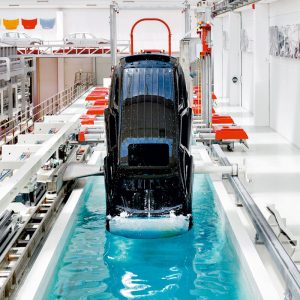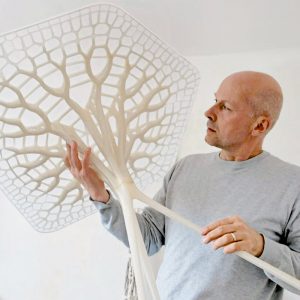A few months ago, we published our 2020 corporate report. In addition to reflecting back on how our business navigated the challenges of one of the most unusual years in history, the report is full of many compelling and inspiring stories. We are pleased to share those with you here. This post focuses on the section Making has meaning.
As the global population grows, it’s clear the manufacturing sector serves in a vital role. Manufacturers not only imagine, develop and create goods that societies and economies need, but they strive to make products accessible to the largest number of people possible, as quickly as possible. At the same time, manufacturers are working with the reality that the Earth’s resources are scarce and precious. How is the 3DEXPERIENCE platform fueling manufacturing initiatives and innovations? What critical role can industry play in achieving harmony between products, nature and life?
Manufacturing industries challenges
21st century industry combines the virtual and real worlds. This new way of making means discovering new paths for inventing, learning, producing and selling. Think about Tesla or Amazon: two examples of companies that disrupted a well-entrenched market by offering new approaches to create new value. These companies also put user experience at the core of their offerings.
Indeed, the “factory” of tomorrow will focus on creating experiences over products, a reality that will require very different business models and new types of ecosystems than traditional supply chains.

Virtual experience platforms provide the necessary infrastructure to transform commerce, distribution, transportation and tourism. They are creating as fundamental a shift now as the printing press did in the 15th century. Virtual twins revolutionize our relationship with knowledge and know-how: data generated from digital experiences offer innovators the opportunity to develop new offerings that add large amounts of value and drive towards a sustainable future. They harmonize product, nature and life.
COVID-19 revealed the fragility of supply chains. It exposed how securing the upstream supply chain is crucial to survival. From sourcing to distribution, the 3DEXPERIENCE platform helps design more efficient supply chains, plan agile production and secure comprehensive downstream processes. The platform also provides a comprehensive solution for designing, planning, simulating and continuously optimizing overall supply chain processes in a virtual environment. This starts with managing supplier-related costs with ENOVIA, including approving and qualifying each new component to promote the opportunity for reuse, introduce parts from preferred suppliers and minimize validation costs. When this is in place, the supply chain has protection from disruption because this data helps create understanding of the existing supply network to then determine how it can be optimized or redesigned. Our NETVIBES solutions also play a role in reworking modern supply chains. By connecting enterprise, suppliers, customers and market data in the 3DEXPERIENCE platform, NETVIBES monitoring solutions allow players across the supply chain to detect and reduce the impact of disruptions. Further, the 3DEXPERIENCE Marketplace can be leveraged to find an alternative supplier of a similar part.
Sustainable development in manufacturing
When manufacturers abide by circular economy principles – eliminating waste, keeping materials in the loop and powering the industry through renewable energy – it’s is not only benefits the environment, it opens growth opportunities. Circular manufacturing helps make a business case for sustainability, but it also creates a shift: it’s no longer about just one unit operates in the supply chain, it’s about how an entire value network – from suppliers, production plants, the marketplace, consumers and retailers – works together. To successfully navigate this new complexity requires diverse knowledge and know-how, and tight collaboration. Virtual worlds enriched with modeling, simulation, optimization, collaboration and business process execution and performance empower the participants across the value chain to test infinite innovations.

One example of this comes from Geico Taikisha, a world leader in automated body painting systems. To meet demands in this era of mass personalization, the company knows its customers want flexibility in production. One way they approached this was by creating Smart Paintshop: a connected solution based on DELMIA Apriso that manages, guides and documents each step with pinpoint precision, resulting improved efficiency, safety, quality and cost. It also helps address the company’s ambitious sustainability goals. The 3DEXPERIENCE platform manages communications between end-user systems, complemented by an IoT system and technologies that facilitate energy and design management. All of this helps Geico Taikisha provide its customers with an end-to-end approach to meet increasing demand for high-quality, low-cost products with high levels of customization.
Production Insights
Dassault Systèmes knows that observation and analysis help create powerful insights into production processes. But often, this knowledge is buried in requirements, regulations, client and reseller feedback, after-sales service reports, contracts, scientific publications, research reports and clinical trial results. To make it easier for our customers to interpret and organize text data with ontologies and AI-driven semantic analysis, last year we strengthened our data science capabilities by acquiring Proxem. A specialist in advanced semantic processing based on natural language processing (NLP) and machine learning, Proxem’s solutions help users turn textual data into ontologies and actionable insights. This helps 3DEXPERIENCE platform users enrich their virtual twin experiences, leading to unprecedented opportunities for collaboration, innovation and the creation of new products and services.
A different, but important, type of insight into production is how companies can protect workers on the factory floor. MyHealth@Work is a Dassault Systèmes service rooted in DELMIA. L’Occitane en Provence both helped to develop this and serve as the pilot client. The goal is preventing musculoskeletal disorders among staff by using a virtual twin to quickly capture real-world situations and operational procedures of each workstation then analyze the tasks performed in the production and packaging shop floor. Method engineers access a dashboard that combines two algorithms: Smart Posturing Engine, which automatically positions a virtual manikin, and Ergo4All, which ergonomically assesses the manikin’s posture to determine the risk of joint or musculoskeletal problems. This frees method engineers to spend more time on prevention, and workstation operators have the means to be more aware of information related to their own health.
Design for Life
The final section of Making has meaning explores the results of a program called Design for Life. Launched in 2016, Design for Life focuses on innovative practices and processes for sustainability by design. In 2020, we collaborated with design and architecture magazine Dezeen to share more about the program, offering testimonials from forward-looking designers and architects whose work lies at the crossroads of technology, science and nature. Their work holds the promise to have a radically positive impact on today’s world, creating new ways of thinking and making. Design for Life shows how we can represent the imaginary as tangible and realizable elements, and be inspired by the structures of living things. A few of these stories include:
- Arthur Mamou-Mani creates sustainable designs based on natural processes, and brings his projects to life in an integrated FabLab. He believes that “it’s very important that designers start thinking beyond the timeframe of their project. They need to start thinking of where the material came from, where is it going, how can it be reconfigured – the entire lifecycle of a project needs to be taken into consideration.” His vision is displayed in an installation comprised of a dynamic grid of 3D-printed modules that cascade through the space as if taken by the wind. The modules were designed in the XGen solution, which allows parametric models to be created within the 3DEXPERIENCE platform, then 3D-printed with PLA, a bioplastic made from fermented sugar. But there’s more: the installation also features a crusher that breaks down the printed modules into pellets, which can immediately be reused to print new modules.
 Bringing together science, art and computational design can help us get closer to the way organic forms work which in turn can create structurally-efficient architecture that produces no pollution. Exploration Architecture, lead by British architect Michael Pawlyn, is known for rethinking approaches to construction by studying biomimicry and innovation inspired by nature. The firm strives to understand the complexity and efficiency of organic structures and then model and 3D print structure, which means using resources more sustainably. For example: through the study of a bird’s skull they created a model of an incredibly light but efficient pavilion structure with very thin surfaces that are transformed into solid structures by folding and bending.
Bringing together science, art and computational design can help us get closer to the way organic forms work which in turn can create structurally-efficient architecture that produces no pollution. Exploration Architecture, lead by British architect Michael Pawlyn, is known for rethinking approaches to construction by studying biomimicry and innovation inspired by nature. The firm strives to understand the complexity and efficiency of organic structures and then model and 3D print structure, which means using resources more sustainably. For example: through the study of a bird’s skull they created a model of an incredibly light but efficient pavilion structure with very thin surfaces that are transformed into solid structures by folding and bending.- Julia Koerner‘s work blurs the boundaries between architecture, fashion and product design. She draws inspiration from natural shapes, constantly exploring the possibilities of biomimicry in design. In one of her best-known projects, she took close-up photographs of butterfly wings and created an algorithm based on what she saw. That was used to reproduce the motif by applying 3D printed bristles on a flexible fabric that moves and flows organically, coming alive with each movement.

